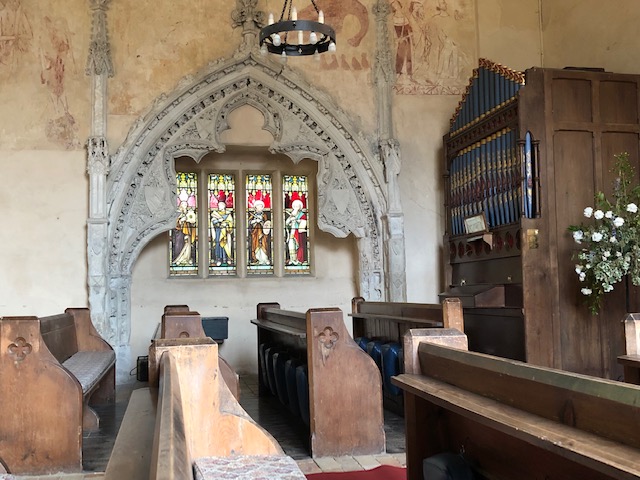Webmaster Notes
The wall paintings get far more interest than the chapel. I guess it is because of the subject material and the fact that they are eccesiatical and not just historical. The fact is that the chantry is probably more important to the village and regions history than the wall paintings
As Thomas Organ has put in another quote for work on the wall paintings it was good op to review the pages relating to them. The chantry is one of them and a subject that I think deserves far more interest. The fact that the chapel is there in the first place seems to be of little interest that have some interest in the church in general.
The Chantry Chapel in St. Mary the Virgin Belchamp Walter
The remains of the Chantry Chapel are one of the most striking artifacts that you will find in the
Church. The entrance arch is surrounded by
Medieval Wall Paintings, the dates of their painting is under speculation.
The significance of this chapel seems to be overlooked by many who
encounter it. This seems to be the case with the casual visitor and by those that visit the Church on a regular basis. Belchamp Walter and the country in the 14th and 15th centuries would have seen this chapel as an important feature. The description of the Privately Built Chapel (Chantry) on Wikipedia gives a clue to this significance.
The destruction of the chapel, presumably in 1574 if the graffiti on the right hand pillar is authentic, was due to reformation actions taken by the Tudors
Top
The definition of a Chantry: - from the Wikipedia page
Privately built chapel
Secondly, a chantry chapel is a building on private land or a dedicated area or altar within a parish church or cathedral, set aside or built especially for the performance of the "chantry duties" by the priest. A chantry may occupy a single altar, for example in the side aisle of a church, or an enclosed chapel within a larger church, generally dedicated to the donor's favourite saint.
Many chantry altars became richly endowed, often with gold furnishings and valuable vestments. Over the centuries, chantries
increased in embellishments, often by attracting new donors and chantry priests. Those feoffees who could afford to employ
them in many cases enjoyed great wealth. Sometimes this led to corruption of the consecrated life expected of clergymen.
It also led in general to an accumulation of great wealth and power in the Church, beyond the feudal control of the Crown.
This evident amassing of assets was one of the pretexts used by King Henry VIII to order the Dissolution of the
Monasteries in England.
The descritption of the chantry from the Church guide.
Britsh History On-Line says:
Monuments: In nave — in N. wall (see Plate, p. 20), (1) said to be to Sir John Boutetort, 1324 or 1325, and Maude (Fitz-Otes) his wife,
arched recess probably forming canopy for former altar tomb and entrance to former chantry-chapel, moulded and two-centred arch, cinquefoiled, sub-cusped and carved with foliage and flowers, points of main cusps carved with grotesques, and on main spandrels four shields of arms alternately,
(a) a saltire engrailed, for Boutetort, and (b) bendy with a quarter, for Fitz-Otes; crocketed and moulded label with carved finial, moulded responds carved with foliage; arch flanked by square panelled buttresses with panelled, gabled and crocketed pinnacles, on buttresses numerous small shields of arms including Boutetort, Fitz-Otes, Boutetort with a label of five points, Fitz-Otes impaling Boutetort, and quarterly a bend, for Beauchamp;
at back of arch, moulded and carved springers of vaulted roof of former chapel, or canopy of tomb, springing from semi-circular vaulting shafts with moulded capitals.
The "said to be" statement is curious here as the shields of arms were identified (
I think correctly). The BHO identification of Fitz-Otes should be fitx Otho. Otes is a much later name from a similar georaphic area.
Shields of Arms
The description from BHO describes: "a quarterly bend, for Beauchamp" as seen on the Chantry Arch.
A bendy or bend is a diagonal stripe on the coat of alms.
Background to this page
Having seen this page found by those making an Internet search I have decided to add
a bit more context.
The statement made by British History On-line that the tomb is "said to be of Sir John Boutetort,
1324 or 1325, and Maude (Fitz-Otes) his wife", is pretty much confirmed by the presence of the coats of arms
that adorn the remains of the
arch. There are also those of Botetourt,
Fitz-Otho (Fitz-Otes impaling Boutetort) and
de Beauchamp.
Inscription (carving/graffiti) on left column - BIQUG---- TUYU---? 1574
- probably the person commissioned to destroy the chantry.
At first I thought this was a Civil War "fallout" but the dates do not match. I now think that the Chantry
was destroyed 100 years previous to the Civil War.
This was due to the continuation of the English Reformation by the Elizabethan
monarchy.
The destruction/removal of the Chantry Chapel is another example of the Lost Heritage
that is rife in many English churches. The significance of the Botetourt connection
to the village of Belchamp Walter is
equal to that of the marriage between Geofrey de Mandeville to Rohse de Vere ans the possible destruction of a
memorial that was located in the Chancel of St. Mary's.
